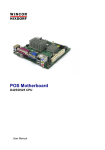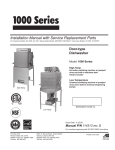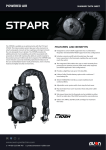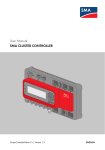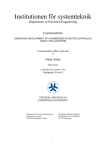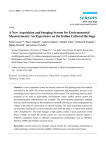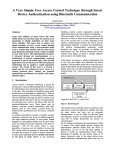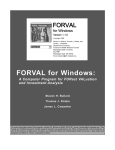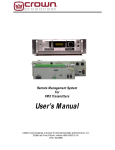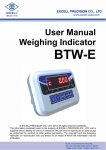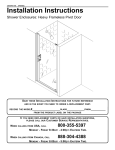Download Approach Draft - Senior Design
Transcript
3. Approach The design constraints, technical and practical, mentioned in section 2, provide an exclusive focus on the development of the ADCI. However, an analysis of the design aspect is taken into consideration, individually, to determine the approach of the ADCI prototype; this approach is explained in detail in the following sections. 3.1 System Architecture The ADCI integrates different sensors along with a long distance communication system. A diagram of the system layout is provided below in Figure 3.1. Figure 3.1: System layout for the ADCI The microprocessor is the central piece of hardware in the system, collecting the information received from the different sensors, logging that information, and sending it on to the cellular module. In the best case the temperature sensor and GPS would be completely separate from the rest of the system; allowing for them to both be easily replaced later on. The temperature sensor follows this ideal, but the current GPS unit for cost purposes is on the same board as the cellular module. It is; however, isolated from the cellular module and if a separate GPS is needed later it can be easily added to the system and the current one can be disabled. As stated above the microprocessor will be logging the information gathered from the sensors and storing it in memory stored off the chip. This will enable a back-up of the information in case any of it is not properly transmitted. There are many different storage devices that can be used and these are discussed further on. The information gathered in the microprocessor is buffered and then sent onward to the cellular module at one minute intervals. The cellular module is able to interpret these messages and turn them into text messages which can then be sent to either another cellular device or to an e-mail address where the information can be gathered by a base station computer. If there are any problems with sending the data a message can be relayed back to the microprocessor to have it make a note of the failure to send; thus allowing data which failed to transmit to be quickly found on the accompanying data logger. 3.2 3.2.1 Hardware Microprocessor The microprocessor has many tasks in the ADCI. It must read on data from the different sensors and create buffers for this data. At regular intervals it will store the data it has collected on the attached data logger, as well as send the current sensor readings to the cellular module at one minute intervals. The microprocessor must also be able to identify when the cellular module has an error sending and ensure that the data is not lost. There are many different types of microprocessors, but due to previous knowledge only the PIC family was researched for this task; specifically the PIC24HJ32 using the mini-Bully and the PIC18 using the PICAXE microprocessor system. Both of the microprocessors will work for the ADCI and the decision on which was used was not based on any physical parameters. The team leader has worked with the PIC18 and PICAXE system before and is more comfortable with it than the PIC24. The main embedded programmer in the group has worked with both the PIC18 and the PIC24 with mini-Bully before, so both were quite familiar. In the end the PIC18 with PICAXE system was chosen due to the group overall being more comfortable with it. 3.2.2 Sensors The ADCI has to be capable of measuring location, altitude, speed, and temperature. In order to meet these needs, several sensors are required. The most important measurement for the ADCI is location. Location is measured using a GPS module that is incorporated within the Terminus cellular module. The Terminus cellular module was chosen for the ADCI because of its capability to measure GPS data and communicates as explained in section 3.2.3. The next sensor on the ADIC is the temperature sensor. There are many types of temperature sensors available. The first sensor consider for the ADCI was a liner LM34. The LM34 is a three wire IC sensor in a TO-92 package. This sensor is inexpensive and is easy to interface with the microcontroller. The LM34 has a temperature range of -45°C to 148°C providing a suitable range for the ADCI [1]. After consulting with an experienced professor, it was determined the LM34 would not be the most suitable choice for the ADCI. Since the LM34 is a linear type temperature sensor, operating it at low temperatures will cause electrical noise over the signal wire. This will cause the microcontroller to read erratic voltages into the ADC yielding erroneous data. Since the balloon will be reaching altitudes of up to 10 miles, the ADCI will encounter very low temperatures causing the LM 34 to give incorrect data. The current solution to replace the LM34 is the DS18B20 temp sensor. The DS18B20 is a programmable resolution one-wire digital thermometer. The DS18B20 temp sensor can be read using 12bit resolution where as the LM34 could only be read using 10bit resolution. The increased resolution means the sensor is more accurate. The DS18B20 does not just change its voltage as a function of temperature, it also has a built-in buffer and hi and low temperature triggers. This enables temperature ranges to be set within the sensor itself to notify of an over or under temperature situation. Since the IC has a buffer, it contains the received information until the microcontroller accesses it. A block diagram of the DS18B20 is shown below in figure 3.2. Figure 3.2: Block diagram of the DS18B20 thermometer [2] The thermometer can be used as a one-wire sensor, meaning that only one wire is needed to read and power the unit. There is a built in parasitic capacitor that the sensor pulls power from while the microcontroller is reading the data. The DS18B20 has a temperature range of -55°C to 125°C. This will satisfy the temperature requirement for the ADIC. This sensor will be implemented on the ADCI. The ADCI is designed to allow for added sensors in the future. The possibility of having more sensors added allows the user to customize the ADCI to their particular needs. It would be easy to incorporate a barometric pressure sensor or some accelerometers to add to the collected data. This data can also be processed by the microcontroller, data logged and wirelessly transmitted just as all the current sensors are capable of. Other data collection devices may include an onboard camera. A camera that has remote triggering capability could be triggered by the microcontroller to take pictures periodically. The pictures cannot be sent through wireless communication or stored in the ADCI’s data logging module. All pictures are held in the camera’s internal memory where the user can access them once the package is on the ground. 3.2.3 Data Logging As mentioned above, the ADCI requires data logging capability. Due to the possibility the cellular module fails to send a message, the current sensor data must be stored for the user to access after flight. The microcontroller gathers the data from all the sensors, including GPS location, and has to store it all someplace. The microcontroller has enough non-volatile memory to store a few samples of the sensor data but not enough to store all data recorded in a two hour flight. In order to retain all measured data, a data logger is required. To meet the data logging requirements for the ADCI, several criteria must be met. The most important requirement for the data logger is it has enough storage space to hold all data collected during a two hour flight. The second is the type of data logger used must be able to interface with the microcontroller. The third requirement is that the data logger be removable from the ADCI. This will allow the user to retrieve the data once the ADCI is on the ground without any support from the ADCI unit. The final requirement for the data logger is cost. Data loggers have a wide range of cost so a reasonably priced data logger that meets all requirements is desirable for the ADCI. The first step to finding a data logger is determining the amount of storage capacity required. For the ADCI, the collected data will be stored once every minute over a two hour period of time adding up to a total number of 120 messages. The amount of data accumulated for one flight is found by using equation 1 shown below. [1] The GPS, temperature and other sensor data measured by the microcontroller, is estimated to be140 bytes. Having the estimated number of bytes per message and the total number of messages, the data storage space required is calculated as shown below using equation 1. After determining the number of bytes required for a two hour flight, we have narrowed down the total choices of data storage to a few that can meet the needs of the ADCI. The easiest and cheapest way to store data from the microcontroller is by using an Electrically Erasable Programmable Read-Only Memory IC or (EEPROM). An EEPROM is an integrated chip that is used for non-volatile data storage. The microcontroller can read and write data to an EEPROM as need without any problem. It provides adequate storage space but it is not a removable device. If an EEPROM was used, the user would be required to have the ADCI connected to a computer in order to extract the data that is stored on the IC. This method is not practical because of the added difficulty for the user to retrieve data. Another data storage device is a secure digital card or (SD card). SD cards are very popular in many electronics that stored data such as, digital cameras and cell phones. SD cards provide data storage ranging from a few MB ranging to 32GB; greatly exceed the 16.8KB required by the ADCI unit. A disadvantage of the SD card is cost. The SD cards themselves are not expensive but the card slot that is used to read and write to the SD card itself is. This would accrue added cost to the ADCI package but would also make it more user friendly. Another disadvantage is, it is more complicated to read and write to an SD card using the microcontroller. Although it is more expensive and more complicated to interface, it is worth the tradeoff to have the data stored on a removable more user friendly data storage medium. Another data storage possibility is adding a USB port to the ADCI that will allow a jump drive to be inserted to store data. Jump drives are inexpensive, readily available and widely used for portable data storage. The storage capacity of jump drives range into the hundreds of GB, providing more than enough storage space for the ADCI application. USB breakaway boards are available providing an interface for the microcontroller to read and write to an inserted jump drive. This method of data storage will be the most portable and the least complicated within the price range for this project. 3.2.4 Communication The cellular module is the chosen device to communicate the data, primarily because of its speed to transfer data. Also, the procedure to set up the link between two peers, a computer and the ADCI, is not time consuming. The connection for the Cell module is made towards the internet to achieve a point to point connection between the two. Think of the cellular module as a cell phone whereas a phone number is not needed; the connection is done with AT&T wireless. This approach has the advantage of shifting the control of the application through the modem directly on a cell phone tower, making it readily accessible from the ADCI to the computer via text messaging. The connection is billed on the amount of data exchange (number of text messages transferred) and not on the time spent connected, or the distance the module has to cover. This makes it plausible for the module to always stay connected and ready to receive/send data on demand. Shown below in figure 3.3, is the block diagram of the Cell module. FIGURE 3.3: Cellular module block diagram [3] Above in figure 3.1, there is a RS-232 block; this is where the communication will come from when the cell module is active. For a clear picture of where the RS-232 connects on the cell module, see figure 3.4 shown below. Figure 3.4: Serial Interface plug [3] The RS-232 connects to the computer so that the messages being communicated from the ADCI will get transferred to its correct location. The Embedded interface is a 50 pin dual row header that allows the ADCI to access many of the available ports and features of the cell module through a single interface [3]. Figure 3.5 shows the connection points. Figure 3.5: 50 pin dual row header [3] As shown above in figure 3.5, the connector is located on the bottom of the unit. To aid the ADCI, the interface divides up into two groups: General Purpose I/0 (input and output) interface, and GPS Receiver interface. This enables the module to be accessed through a single port. 3.2.5 Power Supply ADCI uses Lithium Sulfur Dioxide (LISO2) Batteries to supply energy. Each battery has a voltage of 2.9 V, and putting 4 of them in series allow approximately 12 V for the ADCI. The LISO2 provide the ADCI with mobility, portability, and reliability. The LISO2 batteries are decided due to the power needed for the ADCI power consumption it uses. Lead acid, nickel metal-hydride, and lithium-ion are three types of batteries that are cable of producing the voltage for the ADCI. Lead acid battery is an inexpensive but heavy battery that could form a memory; a memory in a battery is caused by overcharging of the battery, which will diminish the battery life overtime [4]. With nickel metal-hydride battery, forming of memory and weight are not an effect, but it is expensive. Lithium-ion battery has less weight and no development of memory, and it is said to have a better life span when introduce to cold weather. With those effects, the LISO2 is chosen for the ADCI. 3.3 Software Software for the ADCI consists of C code to control the microprocessor and Python for the cellular module as well as the GUI. The microprocessor programming allows it to get raw data from the sensors and convert it into a format usable by the cellular module. The cellular module coding is then used to convert the data into a text message which can be sent to any preselected. The GUI’s code will poll the e-mail account and take any new messages and display them in an easy to read format. 3.3.1 Microprocessor The microprocessor cycles through each of the sensors, reading new information off them into buffers. In the case of the GPS it chooses the middle value from the buffer and stores it. For the other sensors the data will be averaged and this number is stored. Every minute the microprocessor takes the current sensor data and sends it on to the cellular module and also saves a record of the sent data in the data logger. After sending the data to the cellular module the microprocessor waits to see if the message can be sent; if not then it makes a note of this in the data logger before starting to read from the sensors again. The state diagram of this process can be seen in Figure 3.6 below. Power ON Stage 0 NO Send timer YES Send Data to Cell Module Stage 5 Read Temp Sensor Stage 1 Successful Read GPS Stage 2 NO Record Failure Stage 6 YES Log Sent Data Stage 7 Read Sensor 2 Stage 3 Log Recorded Data Stage 4 Figure 3.6: Microprocessor State Diagram 3.3.2 Cellular Module As of this moment there is no code of our own in the cellular module. There are built in commands to take input and send it as a text message to a phone number or e-mail address. There may need to be some code added after some testing. For instance we may want it to send the data to a different e-mail in flight by sending a pre-selected message to the module. Also, for cases where the message was unable to be sent from the ground it may be possible to queue the message to be re-sent when in contact range without input from the microprocessor. Power ON Stage 0 Get E-mail Input Stage 1 Check Today’s Flight Data Stage 2 Any Data Yes Pull Data Into GUI Stage 3 NO Wait 1 minute YES Check for New Data Stage 4 NO New Data Figure 3.7: GUI State Diagram 3.3.3 GUI The current GUI state machine is shown above in Figure 3.7. On startup the GUI is supplied an e-mail address by the user where the data is being sent. The GUI then polls the e-mail account for any data from the current day’s flight and displays it along with a timestamp for each piece of data. After the initial start-up the GUI will check the e-mail account every minute for updated flight information and append it to the information on the screen. In the future it may also be possible to display the GPS data on Google Maps to give an idea visually of the balloon’s path. 3.3.4 Usage Cases Provide C orrect E-m ati Inform ail Address on Informatio n Dis ta ght Da ent Fli rr u C plays Graphical User Interface (GUI) User Requests Today’s E reques Sends Requests Dis Flight a ted E-m New E-m reques Sends pdated plays U -mails ils E-Mail Client R eq d d r e ss -mail A u e st E ails a ted E-m ils Data Figure 3.8: GUI Sunny Day Case Figure 3.8 above shows the sunny day case for the GUI. On start-up it asks the user for e-mail address information to poll for data. The user provides information causing the GUI to poll the email account for any e-mails from the current day. The GUI then displays this information for the user. Every minute after that, the GUI polls the e-mail account for any new messages and updates the information for the user. A rainy day case for the GUI occurs if it cannot access the e-mail account. If the user provides incorrect e-mail information the GUI will first try to connect to the e-mail server. If it cannot connect the first step is to check to ensure there is a connection to the internet. If not, it will inform the user and ask them to ensure that the computer is connected. Otherwise, if there is a connection then the GUI will tell the user that something is wrong with connecting to the e-mail account and requests new account information. After this, provided the user gives correct e-mail information, the GUI will poll the e-mail and return to normal operation. This case is outlined below in figure 3.9. rmation l Address Info Request E-mai o Request New Provide Correct E-mail Address Info ne Could Not Con ct Check Internet Connection ec Internet Conn tion Okay Requests Toda y’s E-mails Sends Reques nt Flight Data Displays Curre Figure 3.9: GUI Rainy Day Case ted E-mails E-Mail Client s Info E-mail Addres Requests Toda y’s E-mails Graphical User Interface (GUI) User Provide Incorre ct E-mail Addres s Inf During a sunny day the microprocessor is constantly reading new data off of the attached sensors and occasionally sending the data to the data logger. Once every minute the microprocessor creates a data package containing most recent sensor information and sends it onward to the cellular module. It then waits for the cellular module to say that the message was sent successfully before storing the package and resuming its reading of the sensors. The normal operation can be seen below in figure 3.10. or Data Data Sensors Sends Sensor Log Data MIcroprocessor Data Logger Requests Sens Log Data or Data Sends Sensor Data Send Data Pack ag e nt Data Packag Successfully Se Log Data Pack age Figure 3.10: Microprocessor Sunny Day Case e Cellular Module Requests Sens Send Data Pack age nd Could Not Se Log Data Pack age Send Data Pack ag e nt Data Packag Successfully Se e Cellular Module age Log Data Pack Microprocessor Data Logger Log Error d Package Request Faile Send Failed Pa ckage Send Data Pack age nt Data Successfully Se Package Figure 3.11: Microprocessor Rainy Day Case Above in figure 3.11 the rainy day case for the microprocessor can be seen. The data package that is sent to the cellular module returns a failure to send notice. In this case the microprocessor must make a note along with the logged data that there was a problem sending the package. It then returns to normal operation until a data package is successfully sent. When this occurs, and the microprocessor receives confirmation that it was sent successfully, a request is sent to the data logger for the failed package from earlier and resends that package onward to the cellular module in an effort to transmit any failed data. Reference [1] National Semiconductor Datasheet, LM 34, precession Fahrenheit temperature sensor. [Online]. Available: http://pdf1.alldatasheet.com/datasheet-pdf/view/8853/NSC/LM34.html [2] Dallas Semiconductor Datasheet, DS18B20, Programmable Resolution 1-wire digital thermometer. [Online]. Available: http://www.rev-ed.co.uk/docs/ds18b20.pdf [3] Janus Remote Communications Datasheet, Terminus GSM864Q Hardware User Manual. [Online]. Available: http://www.janus-rc.com/pr/GSM864Q_user_guide.pdf [4] [Online]. Mississippi State University, Senior Design Archives. Available: http://www.ece.msstate.edu/courses/design/2008/pwrsupply/home.html













